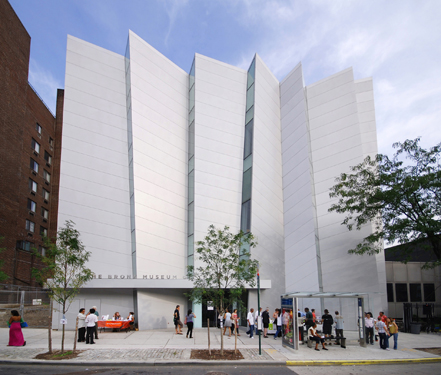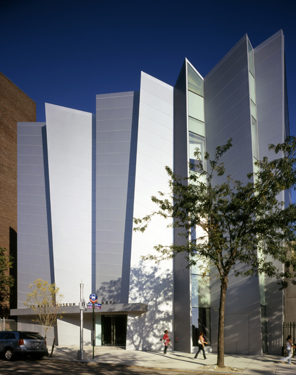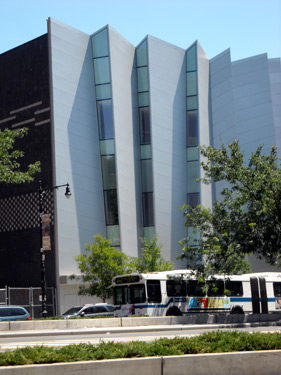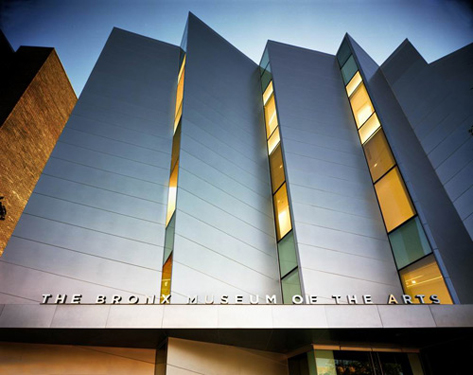The Bronx Museum
of the Arts
The Bronx Museum of the Arts, North Building
Grand Concourse near
165th Street
Arquitectonica / Bernardo Fort-Brescia and Laurinda Spear
2006
Founded in 1971, the Bronx Museum of the Arts moved up the Grand Concourse in 1982 from its first home in the rotunda of the massive Bronx County Building on 161st Street, to occupy what had been the Young Israel Synagogue (1961), on the northeast corner of 165th Street. The small building received a new entrance and a tinted-glass corner lobby in a 1988 expansion by the architects of Castro-Blanco, Pischioneri, and Associates, but exhibition space remained cramped, and the museum felt that, physically, it hadn’t yet made its presence felt. A 1989 municipal promise of new quarters evaporated with a change of mayoral incumbents, and the museum had to reduce expectations and wait until 2006 for the opening of its North Building, a Borough and City-funded annex joined to the older museum by an aluminum passage.
The addition is the work of the firm Arquitectonica, whose graphically assertive style established itself in Manhattan with the fluorescent arc of its Westin Hotel, looming over the intersection of 42nd Street and 8th Avenue. In comparison, the Bronx Museum building is minuscule in scale and modest in means, a three-story concrete-block box lodged in a steep down-slope to the sidewalk. The angle of the hillside determines the progression of interior spaces, as the visitor climbs a ramp from the shallow entrance lobby to a first gallery, then continues up more stairs to the wider second floor, with an unexpected outdoor sculpture garden to the rear, resting on the hillcrest. Sparse interiors expose the economy of the project: wire-cable railings, cylindrical columns, concrete floors, and rectangular rooms.
Completely hiding the building, expressing nothing of its internal organization except the location of the entry, is the Concourse façade, a curtain wall of aluminum folded into variously slanted, sharp-edged vertical pleats that twist and rise from sidewalk to roof. A fascinating, freestanding shape, architects Fort-Brescia and Spear have called it “architectural origami.” Visually, the Bronx Museum has been put on the map.
Fritted-glass windows are set along the north-facing edges of three of these accordion-folds and the south edges of two others, so that outsiders passing in either direction will catch glimpses of the galleries, and insiders can look up and down the boulevard. On the museum’s interior, the folds serve no design function, aside from providing some interestingly tilted windows. But from the outside, the façade affiliates itself strongly to the zigzagging facades and corner windows of the Art Deco apartment houses lining the Concourse. (There’s a good example [1188] at the nearby SE corner of 167th Street, and a brilliant one at 181st Street [2121].) A second, minor key Deco allusion is the patterned black-and-white brickwork on the Museum building’s sides. Maybe Arquitectonica’s roots in Miami, another American preserve of historical Deco, are what sensitized the architects to the Concourse’s stylistic code.
On the other hand, the style of the Museum’s older section seems to be pointedly ignored by Arquitectonica’s metallic outburst in mid-block. That’s because the older building’s days may be numbered. The small north wing is meant to be only the first stage of an ambitious expansion—also designed by the firm—involving demolition of the old galleries and extension of the folded façade southward almost to the corner, where it will run into the flank of a new medium-rise residence facing 165th Street. Income from an apartment house in the revived “downtown” Bronx, it’s hoped, will free the Museum from its long dependence on capricious municipal funding.
David Bady
Photographs:
The Bronx Museum of the Arts, Lehman College Art Gallery and
© Norman McGrath, courtesy Arquitectonica



